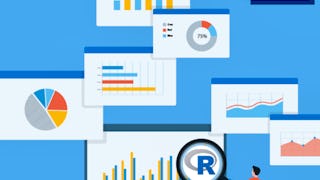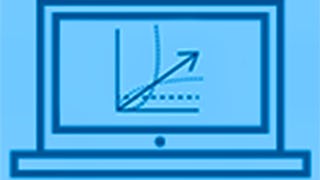This course provides a first look at the R statistical environment. Beginning with step-by-step instructions on downloading and installing the software, learners will first practice navigating R and its companion, RStudio. Then, they will read data into the R environment and prepare it for summary and analysis. A wide variety of concepts will be covered, including sorting rows of data, grouping by variables, summarizing over variables, pivoting, and creating new variables. Then, learners will visualize their data, creating publication-ready plots with relatively little effort. Finally, learners will understand how to set up a project workflow for their own analyses. All concepts taught in this course will be covered with multiple modalities: slide-based lectures, guided coding practice with the instructor, and independent but structured practice.

Gain next-level skills with Coursera Plus for $199 (regularly $399). Save now.

Arranging and Visualizing Data in R
This course is part of Data Science for Health Research Specialization

Instructor: Philip S. Boonstra
2,887 already enrolled
Included with
Recommended experience
What you'll learn
Become knowledgeable about and conversant in the R environment
Format and manipulate data within R into suitable formats
Develop an intuition for doing exploratory data analysis
Develop a workflow in R
Skills you'll gain
Details to know

Add to your LinkedIn profile
See how employees at top companies are mastering in-demand skills

Build your subject-matter expertise
- Learn new concepts from industry experts
- Gain a foundational understanding of a subject or tool
- Develop job-relevant skills with hands-on projects
- Earn a shareable career certificate

There are 4 modules in this course
Module 1 will cover all of the tasks to get you up and running in R. You’ll learn how to access R, how to navigate it, how to install R packages, and how to create scripts that keep a record of your work. We will also learn about The Global Findex Database 2017, a population-based survey and report that provides a wealth of information on financial access for persons all over the world. Your assessments will use data from The Global Findex Database 2017 to create a table and figure from the report.
What's included
9 videos8 readings4 assignments1 discussion prompt
In Module 2, you will develop insight into how functions work as you are introduced to various functions from the tidyverse, which is a collection of eight R packages useful in data science. The lessons will guide you through performing common data wrangling tasks, such as filtering observations of a dataset and joining data from different sources. By the end of the module, you will have used these tools to reproduce the Indicator Table from The Global Findex Database 2017, which estimates account ownership statistics, including gender and income gaps, for all of the surveyed countries.
What's included
15 videos13 readings5 assignments1 discussion prompt
Module 3 introduces you to R graphical capabilities. You will both learn about different types of plots – including scatterplots, lineplots, barplots, boxplots, and histograms – and how to make them in R. You’ll learn how to create multipanel plots. And you’ll continue to learn good overall R “hygiene” by keeping your code tidy. You’ll put these newly learned skills to work re-creating Figure 1.1 from The Global Findex Database 2017, which shows how account ownership varies by the income level of a country.
What's included
19 videos7 readings4 assignments
Having worked through the first three modules, you’ve (re)produced a table and figure from The Global Findex Database 2017. Now what? In Module 4, you will learn about sharing your work with others: exporting tables and figures from R onto your computer. You’ll be introduced to a means of writing reports in R using RMarkdown. And finally we’ll talk about what happens when you get stuck: how to ask questions and where to get help.
What's included
5 videos4 readings1 peer review
Earn a career certificate
Add this credential to your LinkedIn profile, resume, or CV. Share it on social media and in your performance review.
Instructor

Offered by
Explore more from Data Analysis
 Status: Free Trial
Status: Free TrialJohns Hopkins University
 Status: Free Trial
Status: Free Trial Status: Free Trial
Status: Free TrialJohns Hopkins University
Why people choose Coursera for their career




Frequently asked questions
To access the course materials, assignments and to earn a Certificate, you will need to purchase the Certificate experience when you enroll in a course. You can try a Free Trial instead, or apply for Financial Aid. The course may offer 'Full Course, No Certificate' instead. This option lets you see all course materials, submit required assessments, and get a final grade. This also means that you will not be able to purchase a Certificate experience.
When you enroll in the course, you get access to all of the courses in the Specialization, and you earn a certificate when you complete the work. Your electronic Certificate will be added to your Accomplishments page - from there, you can print your Certificate or add it to your LinkedIn profile.
Yes. In select learning programs, you can apply for financial aid or a scholarship if you can’t afford the enrollment fee. If fin aid or scholarship is available for your learning program selection, you’ll find a link to apply on the description page.
More questions
Financial aid available,
¹ Some assignments in this course are AI-graded. For these assignments, your data will be used in accordance with Coursera's Privacy Notice.






